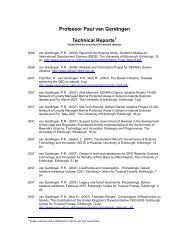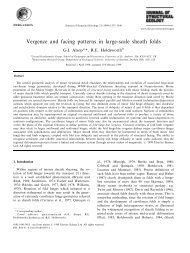REVANCHIST CITY In order to understand what is meant by the ...
REVANCHIST CITY In order to understand what is meant by the ...
REVANCHIST CITY In order to understand what is meant by the ...
Create successful ePaper yourself
Turn your PDF publications into a flip-book with our unique Google optimized e-Paper software.
<strong>REVANCHIST</strong> <strong>CITY</strong><br />
“The rallying cry of <strong>the</strong> revanch<strong>is</strong>t city might well be: ‘Who lost <strong>the</strong> city? And on whom <strong>is</strong> revenge <strong>to</strong><br />
be exacted?’”<br />
Neil Smith, 1996, p.227<br />
<strong>In</strong> <strong>order</strong> <strong>to</strong> <strong>understand</strong> <strong>what</strong> <strong>is</strong> <strong>meant</strong> <strong>by</strong> <strong>the</strong> “revanch<strong>is</strong>t city”, it <strong>is</strong> instructive <strong>to</strong> look<br />
back <strong>to</strong> <strong>the</strong> birthplace of revanch<strong>is</strong>m: late 19 th century Par<strong>is</strong>. Revanch<strong>is</strong>ts (from <strong>the</strong><br />
French word revanche, meaning revenge) were a group of bourgeo<strong>is</strong> national<strong>is</strong>t<br />
reactionaries opposed <strong>to</strong> <strong>the</strong> liberal<strong>is</strong>m of <strong>the</strong> Second Republic, <strong>the</strong> decadence of <strong>the</strong><br />
monarchy, and especially <strong>the</strong> social<strong>is</strong>t upr<strong>is</strong>ing of <strong>the</strong> Par<strong>is</strong> Commune, where <strong>the</strong><br />
working-classes <strong>to</strong>ok over from <strong>the</strong> defeated government of Napolean III and<br />
controlled <strong>the</strong> city for months. The revanch<strong>is</strong>ts (led <strong>by</strong> poet-turned-soldier Paul<br />
Deroulede and <strong>the</strong> Ligue des Patriotes) were determined <strong>to</strong> reinstate <strong>the</strong> bourgeo<strong>is</strong><br />
<strong>order</strong> with a strategy that fused militar<strong>is</strong>m and moral<strong>is</strong>m with claims about res<strong>to</strong>ring<br />
public <strong>order</strong> on <strong>the</strong> streets. They hunted down enemies (<strong>the</strong> Communards) with a<br />
noxious blend of hatred and viciousness, intent on exacting revenge upon all those<br />
who had ‘s<strong>to</strong>len’ <strong>the</strong>ir v<strong>is</strong>ion of French society from <strong>the</strong>m.<br />
<strong>In</strong> <strong>the</strong> 1990s, urban geographer Neil Smith identified a striking similarity between <strong>the</strong><br />
revanch<strong>is</strong>m of late 19th century Par<strong>is</strong> and <strong>the</strong> political climate of late 20 th century<br />
New York City that emerged <strong>to</strong> fill <strong>the</strong> vacuum left <strong>by</strong> <strong>the</strong> d<strong>is</strong>integration of liberal<br />
urban policy. He coined <strong>the</strong> concept of <strong>the</strong> revanch<strong>is</strong>t city <strong>to</strong> capture <strong>the</strong> d<strong>is</strong>turbing<br />
urban condition created <strong>by</strong> a se<strong>is</strong>mic political shift: whereas <strong>the</strong> liberal era of <strong>the</strong> post-<br />
1960s period was character<strong>is</strong>ed <strong>by</strong> red<strong>is</strong>tributive policy, affirmative action and anti-<br />
poverty leg<strong>is</strong>lation, <strong>the</strong> era of neoliberal revanch<strong>is</strong>m was character<strong>is</strong>ed <strong>by</strong> a d<strong>is</strong>course
of revenge against minorities, <strong>the</strong> working class, femin<strong>is</strong>ts, environmental activ<strong>is</strong>ts,<br />
gays and lesbians, and recent immigrants: <strong>the</strong> ‘public enemies’ of <strong>the</strong> bourgeo<strong>is</strong><br />
political elite and <strong>the</strong>ir supporters. New York City in <strong>the</strong> 1990s became an arena for<br />
concerted attacks on affirmative action and immigration policy, street violence against<br />
gays and homeless people, femin<strong>is</strong>t-bashing and public campaigns against political<br />
correctness and multicultural<strong>is</strong>m. Just as <strong>the</strong> bourgeo<strong>is</strong> <strong>order</strong> was perceived as under<br />
threat <strong>by</strong> <strong>the</strong> revanch<strong>is</strong>ts of 1890s Par<strong>is</strong>, in 1990s New York a particular, exclusionary<br />
v<strong>is</strong>ion of ‘civil society’ was being reinstated with a vengeance – an attempt <strong>to</strong> ban<strong>is</strong>h<br />
those not part of that v<strong>is</strong>ion <strong>to</strong> <strong>the</strong> urban periphery.<br />
According <strong>to</strong> Smith, two important fac<strong>to</strong>rs fuelled <strong>the</strong> fire of revanch<strong>is</strong>t New York<br />
City. First, <strong>the</strong> economic recession of <strong>the</strong> late 1980s/early 1990s (which triggered<br />
unprecedented anger amongst <strong>the</strong> white middle-classes; marginal<strong>is</strong>ed populations of<br />
<strong>the</strong> city soon became scapegoats, <strong>the</strong> supposed source of urban unease); and second,<br />
(re)productions of paranoia and fear <strong>by</strong> <strong>the</strong> media that amplified and aggravated<br />
extant sentiments among swa<strong>the</strong>s of middle-class voters seeking <strong>to</strong> affix blame for<br />
<strong>the</strong>ir perceived lack of safety in urban public spaces. It came as no surpr<strong>is</strong>e <strong>to</strong> many<br />
that, in 1993, Rudolph Giuliani was elected mayor on <strong>the</strong> prom<strong>is</strong>e <strong>to</strong> offer a better<br />
“quality of life” for “conventional members of society”. Smith pointed out that<br />
revanch<strong>is</strong>m under Giuliani was sharpened <strong>by</strong> blaming <strong>the</strong> failures of earlier liberal<br />
policy on <strong>the</strong> marginalized populations such policy was supposed <strong>to</strong> ass<strong>is</strong>t. Giuliani<br />
identified homeless people, panhandlers, prostitutes, squeegee cleaners, squatters,<br />
graffiti art<strong>is</strong>ts, reckless bicycl<strong>is</strong>ts, and unruly youth as <strong>the</strong> major threats <strong>to</strong> urban <strong>order</strong><br />
and <strong>the</strong> culprits of urban decay. A particularly repressive attitude <strong>to</strong>wards <strong>the</strong>se<br />
‘culprits’, as exemplified <strong>by</strong> <strong>the</strong> well-public<strong>is</strong>ed ‘zero <strong>to</strong>lerance’ policies of <strong>the</strong> New
York Police Department under Giuliani’s admin<strong>is</strong>tration, can perhaps be taken as <strong>the</strong><br />
hallmark of <strong>the</strong> revanch<strong>is</strong>t city. As <strong>the</strong> city’s economy recovered in <strong>the</strong> mid-1990s,<br />
<strong>the</strong> crime rate dropped fur<strong>the</strong>r (contrary <strong>to</strong> popular perception, it had been falling<br />
before Giuliani’s tenure), public spaces such as Times Square and Bryant Park were<br />
privat<strong>is</strong>ed and commodified, New York City became a major <strong>to</strong>ur<strong>is</strong>t destination, and<br />
gentrification accelerated and diffused in<strong>to</strong> neighbourhoods <strong>by</strong>passed <strong>by</strong> previous<br />
waves of <strong>the</strong> process. The fanfare of success attributed <strong>to</strong> a char<strong>is</strong>matic mayor<br />
squashed concerns over those who had <strong>to</strong> be swept away and/or incarcerated <strong>to</strong> allow<br />
<strong>the</strong>se changes <strong>to</strong> take place.<br />
<strong>In</strong> <strong>the</strong> United States, revanch<strong>is</strong>m goes much fur<strong>the</strong>r than political ideology and moral<br />
crusade – it has worked its way in<strong>to</strong> municipal leg<strong>is</strong>lation. Laws against begging,<br />
panhandling, sleeping or urinating on sidewalks and in o<strong>the</strong>r public spaces are<br />
increasingly used <strong>to</strong> cleanse <strong>the</strong> public spaces used <strong>by</strong> <strong>to</strong>ur<strong>is</strong>ts, <strong>the</strong> middle-class and<br />
wealthy residents and v<strong>is</strong>i<strong>to</strong>rs. As cities compete aggressively <strong>to</strong> make <strong>the</strong>mselves<br />
attractive places <strong>to</strong> live in and in which <strong>to</strong> invest, <strong>the</strong>y are more willing <strong>to</strong> impose<br />
harsh penalties on those people seen as ‘undesirable’ <strong>by</strong> <strong>to</strong>ur<strong>is</strong>ts, shoppers,<br />
commuters, and inves<strong>to</strong>rs. Municipal ordinances have been mobilized <strong>to</strong> criminalize<br />
behavior that <strong>is</strong> offensive or unpleasant <strong>to</strong> <strong>the</strong> resident and v<strong>is</strong>iting middle classes.<br />
Fur<strong>the</strong>rmore, <strong>the</strong> punitive strategies <strong>to</strong> deal with ‘unruly’ citizens are usually put<br />
forward <strong>by</strong> <strong>the</strong>ir architects as common-sense, a fait accompli, even sacrosanct.<br />
Smith’s revanch<strong>is</strong>t city <strong>the</strong>s<strong>is</strong> has proved <strong>to</strong> be one of <strong>the</strong> more influential in urban<br />
studies in recent years. He stated that revanch<strong>is</strong>m was not something unique <strong>to</strong> New<br />
York or American cities, but something common <strong>to</strong> <strong>the</strong> restructured urban geography
of <strong>the</strong> late capital<strong>is</strong>t city. Th<strong>is</strong> invited o<strong>the</strong>r researchers <strong>to</strong> take up <strong>the</strong> <strong>is</strong>sue of <strong>the</strong><br />
applicability of revanch<strong>is</strong>m <strong>to</strong> o<strong>the</strong>r urban contexts. MacLeod (2002) traced <strong>the</strong><br />
extent <strong>to</strong> which revanch<strong>is</strong>m has permeated <strong>the</strong> recent ‘rena<strong>is</strong>sance’ of central<br />
Glasgow, Scotland, and argued that <strong>the</strong> d<strong>is</strong>m<strong>is</strong>sive treatment of Glasgow’s homeless<br />
during its 1990s economic recovery suggests that <strong>the</strong> city bore <strong>the</strong> imprints of an<br />
emerging politics of revanch<strong>is</strong>m, but s<strong>to</strong>pped short of saying that fully-fledged<br />
revanch<strong>is</strong>m <strong>is</strong> present <strong>the</strong>re (due <strong>to</strong> <strong>the</strong> ex<strong>is</strong>tence of a range of policy schemes<br />
designed <strong>to</strong> ass<strong>is</strong>t marginalized populations in that city). Atkinson (2003) argued that<br />
certain strands of revanch<strong>is</strong>m have infiltrated urban policies addressing control and<br />
safety in Britain’s public spaces, even if outright vengeance was hard <strong>to</strong> detect.<br />
Uitermark and Duyvendak (2008) found that <strong>the</strong> revanch<strong>is</strong>m of popul<strong>is</strong>t parties in<br />
Rotterdam, Ne<strong>the</strong>rlands, was qualitatively different <strong>to</strong> <strong>the</strong> revanch<strong>is</strong>m identified <strong>by</strong><br />
Smith. It was directed in large part <strong>to</strong> ethnic minorities and especially Muslims (an<br />
attempt <strong>to</strong> d<strong>is</strong>cipline marginal<strong>is</strong>ed ethnic groups), and most supporters of revanch<strong>is</strong>m<br />
were among <strong>the</strong> lower classes. Finally, recent scholarship on cities of <strong>the</strong> Global<br />
South has detected extreme forms of revanch<strong>is</strong>m occurring in Qui<strong>to</strong>, Ecuador<br />
(Swanson, 2008) and Mumbai, <strong>In</strong>dia (Whitehead and More, 2007), as city managers<br />
(under pressure from elite urbanites and business leaders) attempt <strong>to</strong> sweep <strong>the</strong><br />
symp<strong>to</strong>ms of poverty and homelessness out of sight.<br />
Tom Slater<br />
See also: D<strong>is</strong>placement, Exclusionary Zoning, Gentrification, Governance, Homeless,<br />
New York City, Par<strong>is</strong>, Social Exclusion, Surveillance, Urban Policy.
Fur<strong>the</strong>r Readings<br />
Atkinson, R. (2003) “Domestication <strong>by</strong> cappuccino or a revenge on urban space?<br />
Control and empowerment in <strong>the</strong> management of public spaces.” Urban Studies 40 (9)<br />
pp1829-1843.<br />
Bowling, B. (1999) “The r<strong>is</strong>e and fall of New York murder: zero <strong>to</strong>lerance or crack’s<br />
decline?” Brit<strong>is</strong>h Journal of Criminology 39(4) pp531-554.<br />
Lees, L., Slater, T. and Wyly, E. (2008) Gentrification (New York: Routledge).<br />
MacLeod, G. (2002) “From urban entrepreneurial<strong>is</strong>m <strong>to</strong> a ‘revanch<strong>is</strong>t city’? On <strong>the</strong><br />
spatial injustices of Glasgow’s rena<strong>is</strong>sance.” Antipode 34 (3) pp602-624.<br />
Mitchell, D. (1997) “The annihilation of space <strong>by</strong> law: <strong>the</strong> roots and implications of<br />
anti-homeless laws in <strong>the</strong> United States.” Antipode 29 pp303-335.<br />
Smith, N. (1996) The New Urban Frontier: Gentrification and <strong>the</strong> Revanch<strong>is</strong>t City<br />
(New York: Routledge).<br />
Smith, N. (1998) “Giuliani Time”, Social Text 57 pp1-20.<br />
Swanson, K. (2007) “Revanch<strong>is</strong>t urban<strong>is</strong>m heads south: <strong>the</strong> regulation of indigenous<br />
beggars and street vendors in Ecuador.” Antipode 39 (4) pp708-728.
Uitermark, J. and Duyvendak, J.W. (2008) “Civil<strong>is</strong>ing <strong>the</strong> city: popul<strong>is</strong>m and<br />
revanch<strong>is</strong>t urban<strong>is</strong>m in Rotterdam.” Urban Studies 45 (7) pp1485-1503.<br />
Whitehead, J. and More, N. (2007) “Revanch<strong>is</strong>m in Mumbai? Political economy of<br />
rent gaps and urban restructuring in a global city.” Economic and Political Weekly<br />
June 23 rd , pp2428-2434.<br />
Wyly, E. and D. Hammel (2005) “Mapping neoliberal American urban<strong>is</strong>m” in R.<br />
Atkinson and G. Bridge (eds.) Gentrification in a Global Context: The New Urban<br />
Colonial<strong>is</strong>m (London: Routledge) pp18-38.








